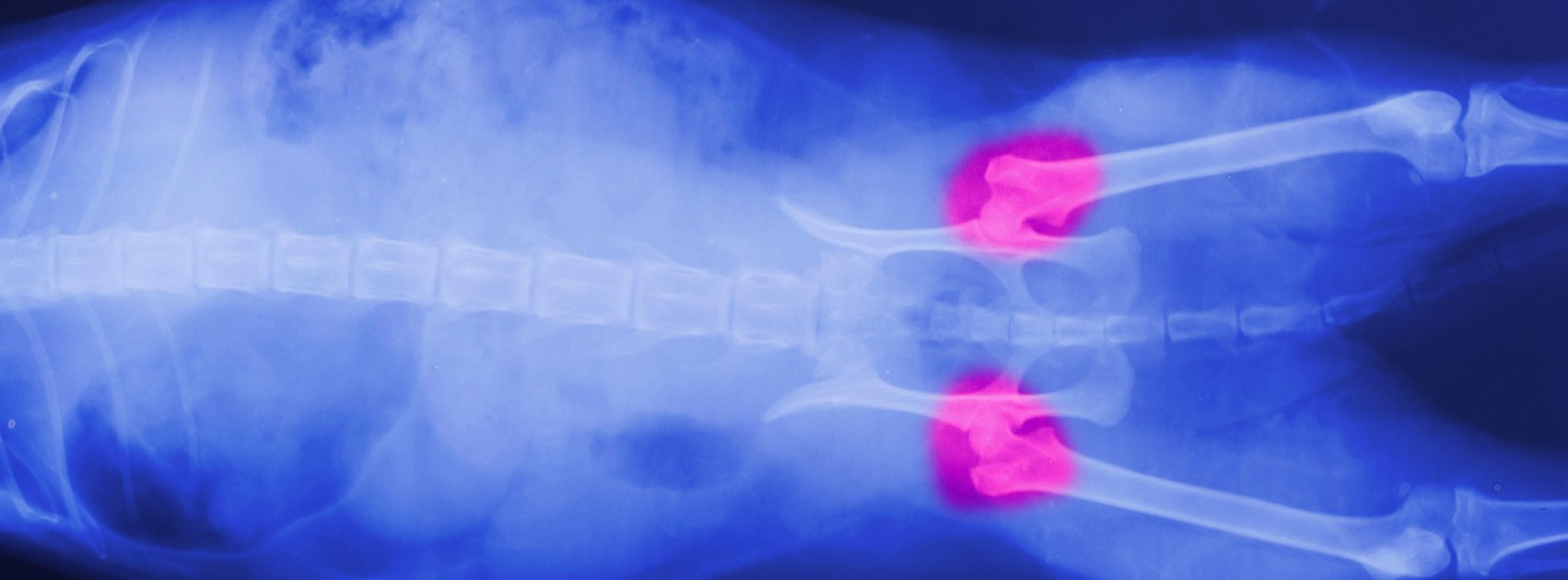What Are the Causes of Canine Hip Dysplasia? Hip dysplasia is a progressive condition in dogs that stems from laxity, or looseness, in the hip joint.
Over time, the joint develops osteoarthritis and, eventually, the ball part of the joint does not fit properly in the socket part of the joint. This results in stiffness, lameness, and limping; eventually, total disability may occur.
There are many causes of canine hip dysplasia, including genetics, weight, and lifestyle factors. Read on to find out more about how to detect, prevent, and treat canine hip dysplasia.
Signs and Symptoms of Canine Hip Dysplasia
While a radiographic evaluation is necessary to diagnose hip dysplasia, there are some signs and symptoms dog owners should be aware of that indicate their dog might be developing the condition.
They include the following:
- Decreased activity and a reluctance to move, run, walk upstairs, or play
- Hind leg stiffness
- Running with the back legs together in a “bunny hop”
- Limping
- Trouble getting up or lying down
- A grating sound in the hip when moving
- Enlarged shoulder muscles (from taking on more of the dog’s body weight)
- Narrowing of the hips
If you notice any of these signs, contact your veterinarian promptly.
How to Prevent Canine Hip Dysplasia
Hip dysplasia is more common in large and giant breeds, but it can occur in medium and even small breeds. In fact, pugs and French bulldogs, both of which are small breeds, commonly develop hip dysplasia. Before you get a puppy, know whether its breed tends to be prone to hip dysplasia.
Also, find out if the parents were evaluated (with x-rays) for hip dysplasia. Two common tests that are done for breeding stock are PennHIP and OFA.
Once you already have your dog, there are some lifestyle choices you can make that might help impede the causes of canine hip dysplasia, even if your dog is prone to it.
- Feed your dog the right amount of food. Excess weight and obesity can cause or exacerbate hip dysplasia in dogs. Growing puppies need more food than adult dogs, so as your pup gets older, be sure to monitor him for signs that he’s getting overweight. Remember, you should be able to feel (but not count) your dog’s ribs without any trouble. Also, feed your large-breed puppy food formulated for large-breed puppies. This will prevent rapid growth, which can lead to hip dysplasia.
- Exercise your dog properly. Discourage puppies from playing or running on pavement or concrete; this is too jarring for growing bones. Instead, take your puppy to play on the grass or sand. Don’t make the mistake of not exercising your dog enough; he should be getting to run around every day.
- Ask your vet whether a radiographic evaluation (such as PennHIP) is appropriate for your dog. This will not prevent hip dysplasia, but it can let you know if your dog is prone to the condition and allow you to make choices concerning lifestyle changes and treatments that might be necessary in the future.
How Canine Hip Dysplasia Is Treated
If your dog has mild hip dysplasia, lifestyle changes such as weight loss and the restriction of exercise on hard surfaces might be enough to keep him happy and pain-free.
If the condition has progressed or if your dog is in a lot of pain, however, that might not be enough. In that case, anti-inflammatory medications, physical therapy, and joint fluid modifiers can help.
Some dogs with hip dysplasia need to have hip surgery to relieve their pain. This can range from making cuts in the pelvic bones to better accommodate the hip joints to performing a total hip replacement.
The fee for this type of surgery can vary tremendously. However, pet health insurance might cover some of this fee. Hip dysplasia can negatively affect the life of your dog.
The condition can cause a lot of pain and suffering, and, as time goes by, your dog could become completely disabled without treatment. If you suspect that your dog might have this condition, seek veterinary treatment promptly to reduce your pet’s pain and help him continue to live a full, active life.










